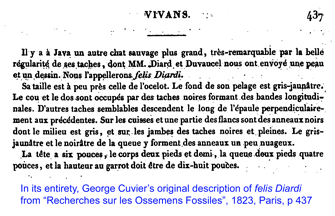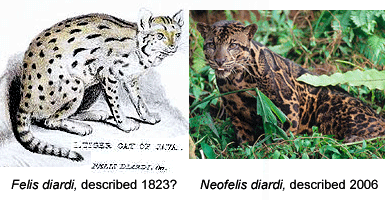The abundance of bluefin tuna in the North Atlantic are the subject of a Census of Marine Life press release . The original tuna papers as well as tuna images and video are are on the CoML Portal.
News
EOL Videos
The 8-9 May 2007 public launch of the Encyclopedia of Life included short appearances by Jesse on Reuters television and on the CBC evening news.
Part stands for the whole
A synecdoche is a figure of speech in which a part stands for the whole, or the whole stands for a part. Taking the first, we might consider a DNA barcode as a synecdoche, in which the short barcode gene fragment stands for whole genome. As in the figure, a COI barcode usually encapsulates the differences found elsewhere in the mitochondrial genome. Because COI barcodes generally capture the discontinuities we recognize as species, we can surmise that differences in this short mitochondrial gene fragment usually reflect differences in the nuclear genome. More study of variation within and among species will help understand why differences in mitochondrial and nuclear genomes appear inextricably linked.
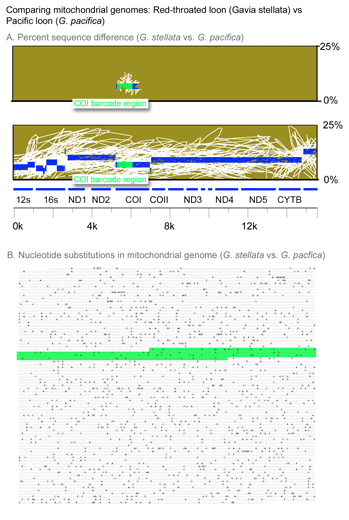
for larger version click here
DNA barcode helps describe new goby, a vertebrate first
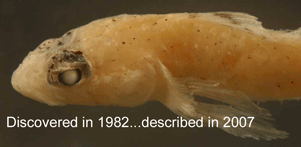 In 12 July 2007 Zootaxa, Benjamin Victor, Ocean Science Foundation and Nova Southeastern University, describes a new species of goby Coryphopterus kuna from the western Caribbean. Although species descriptions often cite DNA sequence differences as evidence for species status, the sequence data itself is usually not shown. Victor’s work is the first vertebrate species description that includes the holotype mtCOI DNA barcode, a simple step that will enable more persons to identify this fish regardless of life stage (egg, larva, and adult forms of an individual all have the same DNA of course) or whether specimen is in bits and pieces, as in stomach contents of a predator for example. (For a look at the strange diversity of fish larva, see Victor’s web-based photographic guide to larval fishes of the Caribbean).
In 12 July 2007 Zootaxa, Benjamin Victor, Ocean Science Foundation and Nova Southeastern University, describes a new species of goby Coryphopterus kuna from the western Caribbean. Although species descriptions often cite DNA sequence differences as evidence for species status, the sequence data itself is usually not shown. Victor’s work is the first vertebrate species description that includes the holotype mtCOI DNA barcode, a simple step that will enable more persons to identify this fish regardless of life stage (egg, larva, and adult forms of an individual all have the same DNA of course) or whether specimen is in bits and pieces, as in stomach contents of a predator for example. (For a look at the strange diversity of fish larva, see Victor’s web-based photographic guide to larval fishes of the Caribbean).
The process that leads to taxonomic recognition of new species is often glacially slow. In this case the holotype specimen was collected off the coast of Panama in 1982, twenty-five years ago. Just as the Human Genome Project generated enormous amounts of raw sequence data, genetic explorations of biodiversity, including DNA barcoding, are creating vast amounts of data that outpace the ability of traditional species descriptions to keep up. Making the sequence and specimen data available through public databases in BOLD and GenBank might lead others to find to new ways of analyzing biodiversity in addition to the stately process of formal species descriptions.
“Heresies” continued news and blog coverage
Jesse’s recent paper, “Renewable and Nuclear Heresies” continues to get a lot of news coverage.
For more interesting reading, the journal PNAS has made the full text of Thomas Gold’s original paper “The Deep Hot Biosphere” available.
Renewable and Nuclear Heresies
Jesse’s paper on “Renewable and Nuclear Heresies” appeared 25 July and attracted coverage in the UK Guardian newspaper.
Earth at Night
We post EARTH AT NIGHT a short note by Nadja Victor and Jesse Ausubel that has appeared in the debut issue of the Electronic Journal of Sustainable Development.
DNA-assisted discovery of new leopard in Borneo worries some taxonomists
Like a telescope that reveals hidden structures in the universe, genomic analysis is a window into biodiversity. For one, differences in DNA sequences help reveal how biodiversity is partitioned into the distinct populations we call species. In Frontiers Zool 29 May 2007, researchers from University of Wurzburg, US National Cancer Institute, and Arizona State University report on mitochondrial DNA and nuclear microsatellite differences between clouded leopards (Neofelis nebulosa) from Borneo (5 individuals), Sumatra (2 individuals), and mainland SE Asia (6 individuals). This report is a follow-up on two papers in December 2006 Current Biol which proposed separate species status for Bornean clouded leopards on the basis of differences in coat pattern and DNA. Wilting et al conclude their updated results “strongly support reclassification of clouded leopards into two distinct species N. nebulosa and N. diardi“. In addition to distinct coat patterns, the two lineages differ by 4.5% in mitochondrial coding genes (cytochrome b and ATPase-8), equivalent to or larger than genetic distances between the other well-recognized species of big cats in Panthera genus (lion, jaguar, tiger, leopard, snow leopard), suggesting the two lineages of clouded leopards have been separated for about 2.86 million years.
This sounds straightforward, but some taxonomists lament the increasing role of DNA in species discovery. In an editorial in current PLoS ONE, researchers from Imperial College insist the Bornean clouded leopard is not really new as it was “described by Cuvier in 1823.” Of course, by this criteria, most forms of larger animals will have been “described” by someone. Cuvier’s original work naming Felis diardi is three short paragraphs based on a single specimen and the illustration is unrecognizable.
To my reading, Meiri and Mace’s editorial implies that most of the important taxonomic work has already been done and if new genetic data appear to upset the traditional scheme, then it is being incorrectly interpreted. They note that there are another 144 mammal species shared between Borneo and the Malay Peninsula, thus “there could potentially be equivalent evidence to merit specific status for all of these; an outcome that would surely be unjustified”. An outcome that would surely be unjustified? This question needs to be answered by science, not by an appeal to taxonomic tradition. It may be that many island populations, which are now considered allopatric forms of widely distributed species, will turn out to be distinct species.
I close with the observation that just as genetic data can suggest splits it can also help reveal synonomies (multiple names that refer to the same species), suggest lumps, and identify forms that do NOT merit separate conservation status. For example, in Proc R Soc B 2005 Johnson et al apply mitochondrial DNA analysis to argue that the Cape Verde kite is not genetically distinct from the Black kite Milvus migrans and does not merit separate conservation status.
Mapping routes for DNA barcoding land plants
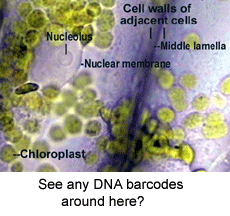 Land plants challenge standardized DNA-based identification. Different groups of land plants are deeply divergent at the DNA level, yet there are relatively few sequence differences among closely-related species. Deep divergences make it difficult to design broad-range primers that amplify DNA from the many kinds of plants, and small differences among closely-related species mean longer sequences are needed to distinguish them. Plant mitochondrial genes including COI evolve too slowly to be useful. The best strategy appears likely to be a combination of 2 or 3 gene regions from the chloroplast genome. Chloroplasts are organelles which house the plants’ photosynthetic machinery and have their own genome, like mitochondria.
Land plants challenge standardized DNA-based identification. Different groups of land plants are deeply divergent at the DNA level, yet there are relatively few sequence differences among closely-related species. Deep divergences make it difficult to design broad-range primers that amplify DNA from the many kinds of plants, and small differences among closely-related species mean longer sequences are needed to distinguish them. Plant mitochondrial genes including COI evolve too slowly to be useful. The best strategy appears likely to be a combination of 2 or 3 gene regions from the chloroplast genome. Chloroplasts are organelles which house the plants’ photosynthetic machinery and have their own genome, like mitochondria.
In May 2007 Taxon, 19 researchers from 12 institutions in 7 countries (Brazil, Colombia, Denmark, Mexico, South Africa, U.K. and U.S.A.) report on tests of candidate barcode regions. Chase and co-investigators outline the rationale and results for selecting and testing potential land plant barcode regions. The finalists were winnowed down from more than 100 coding and non-coding regions in chloroplast DNA by testing 96 pairs of closely-related plant species to see which regions could be amplified and provide discrimination. Although the actual data are not shown in this short update, they summarize their results by proposing three chloroplast gene regions as a standard barcode for land plants: two coding regions, matK and rpoC1, and, either a third coding region, rpoB, or the non-coding psbA-trnH spacer region.
In June 2007 PLoS ONE, Kress and Erikcson, Smithsonian Institution, examine nine potential loci (8 plastid regions which includes the four final candidates in the Taxon paper, and nuclear gene ITS). In this analysis, as in Chase et al report, there are two steps: first, does the region amplify with a standard set of primers, and second, if so, does the sequence enable discrimination of closely-related species. In the 48 pairs of species examined, only two loci, trnH-psbA and rbcL-a exhibited more than 90% success with standard primers. Based on this admittedly small sample, the authors propose a “two-locus global DNA barcode for land plants” in which “rbcL-a provides a strong recognition anchor that will place an unidentified specimen into a family, genus, and sometimes species; the highly variable trnH-psbA spacer will futher narrow the corrrect species identification where rbcL-a lacks discrimination power.”
These are promising starts towards a standardized DNA barcode for land plants. More tests are needed, including analysis of variation within species, as both studies used single specimens for each target species.
Martha’s Vineyard Gazette 12 July 2007
The Martha’s Vineyard Gazette covered Jesse’s 12 July 2007 talk to the Vineyard Conservation Society about the Census of Marine Life.
